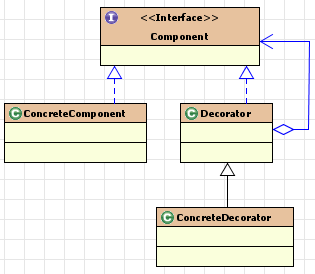设计模式:装饰模式
设计模式:装饰模式
装饰模式是对对象功能增强时,平时使用继承的一种替代方案
一.UML示意图:

二.组成部分:
1. 抽象构件:原始的功能接口2. 具体构件:具体的原始功能类3. 装饰角色:持有具体构件类的对象,以便执行原有功能4. 具体装饰:具体扩展的功能在这里
三.
例子代码:使用装饰模式来演示一个对”行走”功能扩展的例子(听音乐+行走和唱歌+行走)
1. 抽象构件package com.eekq.decorator;public interface Component {/** 原始接口 */publicvoid go();}2. 具体构件package com.eekq.decorator;public class ConcreteComponent implements Component {publicvoid go() {System. out .println( "行走" );}}3.装饰角色来了package com.eekq.decorator;public class Decorator implements Component {/** 持有私有的原始构件 */private Component component ;/** 构造函数,委派给原始构件 */protected Decorator(Component component) {this . component = component;}/**调用原始构件功能,通常就可直接把扩展功能加在此方法中*/publicvoid go() {this . component .go();}}4.具体装饰(这里演示了两种扩展的情况,走路+听音乐和唱歌s)(1).package com.eekq.decorator;public class ConcreteDecoratorListen extends Decorator {/** 构造函数,相关初始化 */public ConcreteDecoratorListen(Component component) {super (component);// code is here}/** 商业逻辑,对原始构件功能的扩展 */publicvoid go() {listen( "听音乐" ); //执行扩展功能super .go();}privatevoid listen(Object obj){System. out .println(obj);}}(2).package com.eekq.decorator;publi cclass ConcreteDecoratorSing extends Decorator {/** 构造子,相关初始化 */public ConcreteDecoratorSing(Component component) {super (component);// code is here}/** 商业逻辑,对原始构件功能的扩展 */publicvoid go() {super .go();System. out .println(sing());; // 执行扩展功能}private String sing() {return "唱歌" ;}}5.客户端调用package com.eekq.decorator;publicclass Main {publicstaticvoid main(String[] args) {/** 原始构件 */Component component = new ConcreteComponent();/**边听音乐,边走路*/ConcreteDecoratorListen cdl = new ConcreteDecoratorListen(component);cdl.go();System. out .println();/**边走路,边唱歌*/ConcreteDecoratorSing cds = new ConcreteDecoratorSing(component);cds.go();}}
四.
总结
优点:装饰模式和继承都是对功能的扩展,而装饰模式使用的是组合,可以不用继承而达到这一效果.使用过多的继承会增加系统的复杂性和偶合性。缺点:装饰模式要产生一些辅助性的对象,但这些对象看上去都比较像,不是很容易检查(好的命名应该是提高检查的一个办法)。






















 1543
1543

 被折叠的 条评论
为什么被折叠?
被折叠的 条评论
为什么被折叠?








